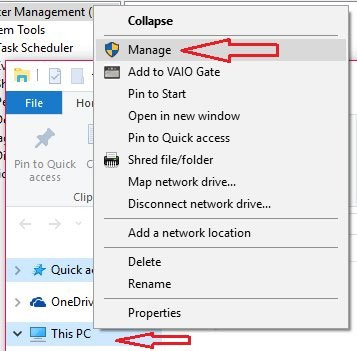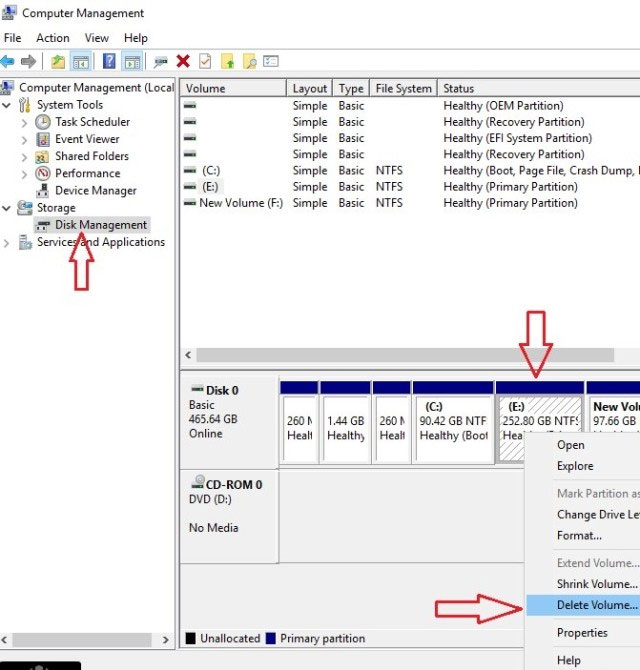How to increase the capacity of C drive on Windows 10, 8, 7 ...
Is your C drive full, causing your computer to run slowly, heat up, and sometimes power down? Want to expand the operating drive (C drive :) without losing data? Please follow the instructions below.
When you install any program or software, it takes up a bit of space in drive C. After a while, the drive is full and you realize the computer is slowing down. Basically, the operating system needs to have a free space in the C drive to run smoothly, but when there is not enough space, it will work abnormally.
Here are 2 ways for users to expand C drive on Windows 7,8,10. The first way is to use the available disk management feature of Windows and the second way is to use 3rd party software.
Method 1: Use Windows disk management feature
Important note: If you don't use this feature properly, you may lose your data. And Windows disk management features limited functionality.
- Open File Explorer by pressing Windows + E.
- Right click on This PC or My Computer (depending on your operating system version).
- Select Manage .

4. Select Disk Management in the Computer Management window.

Looking at the screenshot above, we see the C , E , F drives respectively. If you want to increase drive space C, you must have free space to allocate to drive C. Therefore, you must delete a drive and the space will be moved to drive C. Before deleting the drive Please make sure you have transferred all data there to another drive or external hard drive.
5. Click drive E or any other drive you want to delete (except drive C ).
6. Select Delete Volume . If the drive is large, use the Shrink Volume option to minimize the drive. For example, your E drive is 150 GB and you only need to add 50 GB to drive C. If you select Delete Volume , the entire 150 GB will be transferred to drive C. If you choose Shrink Volume, drive E will be scaled down to 50 GB, and 100 GB has not been allocated in drive E you just need to change the name to one Other letters to form new drives. Now delete the 50 GB E drive so that capacity is transferred to drive C.
7. Right-click on drive C.
8. Select the Extend Volume section. Select Next and Finish .
When using the Disk Management option, users have to delete the space of other drives (except drive C), because you cannot create the remaining unallocated space for any drive using Shrink Volume. . You can only create unallocated space right there. To expand the C drive without deleting any drives, you need to use a 3rd party hard drive partitioning tool.
Method 2: Use Macrorit Partition Expert software
The software is easy to use, free (or if you buy a pro version, it is also much cheaper than other similar software) and works fast. Besides, Macrorit Partition Expert offers many features other than the function of dividing hard drive areas.
Macrorit Partition Expert
- Select drive E.
- Click Resize / Move Volume in the left menu.

3. Just drag from the left to create the space left over to the E drive and press OK .

4. Again you return to the main screen. Select drive C. You will see another window and drag to the right.
5. Click OK .
6. Click Commit at the top. It will restart the computer and within 10 minutes, your C drive space has been expanded.
- New technology helps increase your hard drive capacity 10 times
- Video - Create USB drive with Windows 7 installation
- Why is the hard drive capacity always lower than the manufacturer says?
- Flash drive: capacity will increase, price will decrease
- 1,500 GB hard drive appears next month
- Hard drive capacity will be increased 5 times?
- Maxtor's 1TB hard drive
- A 5 TB hard drive will appear in 2013
- Seagate announced 750GB hard drive
- Iomage releases 1,000 GB hard drive
- Reformatted hard drive format affects Windows XP users
- Hard drive protection
 What is the Snapdragon SiP chip?
What is the Snapdragon SiP chip? How to create a yellow circle around the mouse cursor on Windows
How to create a yellow circle around the mouse cursor on Windows Edit the Boot.ini file in Windows XP
Edit the Boot.ini file in Windows XP 3 ways to restart the remote computer via the Internet
3 ways to restart the remote computer via the Internet